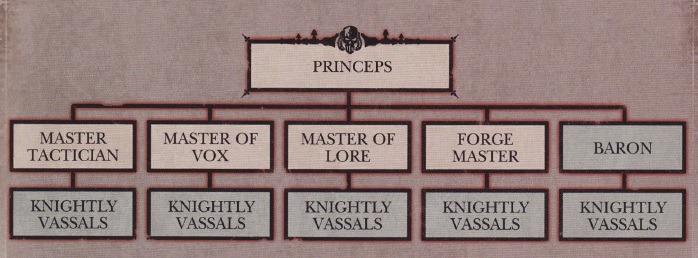Warhammer 40K: Organization of the Knight Houses

Today we delve into the world of the Questor Imperialis and the society of the Noble Houses that own, maintain, and pilot these Lords of War!
Knights, also known as the Questor Imperialis, are smaller and less powerful one-man versions of Imperial Titans. Knights are smaller than Warhound Scout Titans, and can only mount one Titan-class weapon. These can range from Vulcan Mega-bolters to Volcano cannons. Knights themselves are operated from Knightly Houses located on Knight Worlds. Pilots of Knights are known as Knight Scions.
The Society of the Knight Houses
 Organization of Knight Houses sworn to Adeptus Terra
Organization of Knight Houses sworn to Adeptus Terra
There are thousands of Knight houses across the Galaxy. The Knight Worlds operate under a strict feudal system and are typically sworn to either the Adeptus Terra or Adeptus Mechanicus. Each world is led by either a single or number of Knight Houses, whose ranks are made up of Nobles which pilot Knight suits into battle.
Knight Houses sworn to the Adeptus Terra are led by a High King. Directly beneath him are a number of Barons, which each rule a fief of territory. Whole all Barons owe allegiance to their king are not equal and some have different ranks. The baronial rank of Kingsward protects his liege on the field and at court. A pair of crossed swords signify rank of Kingsward. Others may serve as the King’s herald or the gatekeeper of his fortress. Each Baron in turn controls a number of Knightly Vassals, which operate alone or in formations known as lances.
 Organization of Knight Houses sworn to the Mechanicum
Organization of Knight Houses sworn to the Mechanicum
Knight Houses sworn to the Adeptus Mechanicus often accompany the Collegia Titanica into battle or are garrisoned to defend key Forge Worlds. Their organizational structure is similar to those Houses sworn to the Adeptus Terra. Each is led by a Princeps and below him are Barons which can hold a variety of titles. Below the Barons are Vassals. Unlike with Houses sworn to the Adeptus Terra, Mechanicum-sworn Houses may be stationed with a Titan Legion permanently.
A sub-class also exists called the Drovers who looked after the animal herds, as the nobility would not soil their hands with such work. The Drovers used walkers similar to those of their masters, but they were, by law, not armed with any weapons, despite the fact that they faced very serious threats in the form of predators and xenos raids. This forced the Drovers to rely on the Knights for protection, and created a dependency comfortable for the nobles, as it made revolt virtually impossible.
In addition to the Knight war machines, every House had multiple men-at-arms in its employ, resembling Planetary Defence Forces, although possessing a much smaller amount of heavy equipment. On several worlds, artificers and technicians became the most important subjects of the warrior nobility. They maintained the Knight walkers, and over time styled themselves as a priesthood for the half-forgotten mysteries of technology called the Sacristans. They arbitrated between the Knight Houses and ensured that the headstrong nobles did not wipe out one another in bitter feuds by ritualising the values of Duty, Honour and Valour. With the acceptance of these values, the Knights became known as The Chivalry.
In addition to the threat presented by hostile Houses, Knights had to conduct frequent battles against their worlds’ indigenous predators. Hunting these beasts honed their martial skills into a deadly art. The Knights themselves would retire when they reached old age, passing their Battle Armour down to their heir, and in its stead donning the armour of a Knight Warden. They would then take the task of protecting the household and lending its members their advice. Knights formed family units to fight with the Titan Legions or alongside the Imperial Guard. Knights of a given house would be led by a noble holding the rank of a Lord, or the corresponding title of a Seneschal if he happened to be a Warden.
Some Knights do not owe allegiance to any House, and instead wander the galaxy as Freeblade Knights.
Want to learn more about Knights? Check out the Lexicanum!





